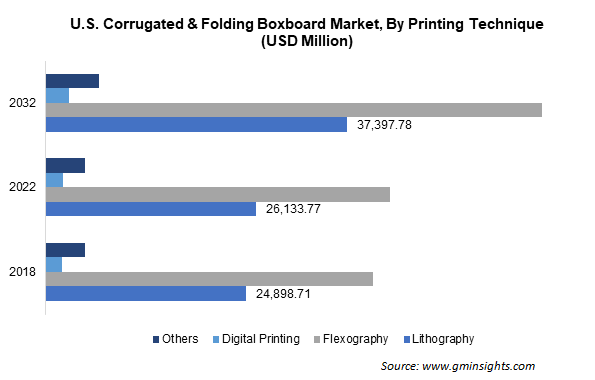Home > Packaging > Packaging Materials > Paper and Cardboard Packaging > U.S. Corrugated and Folding Boxboard Market
U.S. Corrugated and Folding Boxboard Market Analysis
- Report ID: GMI4599
- Published Date: Nov 2022
- Report Format: PDF
U.S. Corrugated and Folding Boxboard Market Analysis
With respect to the product category, the industry bifurcates into corrugated boxes and folding boxboards. The folding boxboard (FBB) segment is projected to garner over USD 23 billion by 2032. FBB packaging has a storage-friendly format and involves shorter production time and low production costs, making it a preferred alternative over its counterparts. Besides, the exceptional attributes, such as efficiency in the production and packing process, unparalleled quality, and performance associated with the product, will propel segment revenues through the coming years.

Based on printing techniques, the U.S. corrugated and folding boxboard market is segregated into lithography, flexography, digital printing, and others. The flexography segment is slated to showcase more than 3.5% CAGR between 2023 and 2032. Flexography, also known as flexo, is an extensively utilized, quick, and economical technique of printing simple designs to a range of packaging materials, including corrugated-cardboard boxes, plastic and paper containers, envelopes, tape, metal foil, etc. The method is highly versatile and sustainable and delivers high-quality images at affordable prices fostering its adoption over the forthcoming years.

Regarding the end-user, the food and beverages segment is predicted to amass more than USD 48.5 billion by 2032, owing to the flourishing retail and e-commerce sector and the proliferation of online sales channels across the country. The region has also witnessed a considerable rise in demand for packaged and processed food items, which has resulted in the increased uptake of corrugated & folding boxboard, transforming the market dynamics over the projection period.

Regionally, the Northwest U.S. corrugated and folding boxboard market is poised to depict more than 3.5% growth rate from 2023 to 2032 and record a valuation of over USD 25 billion by 2032. Northwestern U.S. states such as Washington, Oregon, Idaho, Wyoming, and Montana have a robust pharmaceutical sector. An increasing number of pharmaceutical manufacturers making their foray into e-commerce and offering home delivery services will fuel the regional industry trends through 2032.

